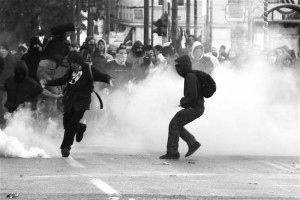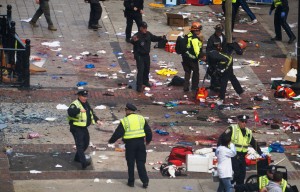Is it easier for youngsters to take up violence today? Ritika Turakhia reflects on the issue of dwindling consciousness among the youth
What do you do when a stranger bashes you up? What do you do when someone offends your religion, your country, your family, or something really dear to you? What do you do when you feel like you have been wronged, treated unjustly or when you’re fed up of being pushed around?
Taking the law into one’s own hands has always been the knee-jerk reaction to being treated unfairly throughout history, especially among the youth. From the hippies who rebelled against war in the 60s to politically-motivated skinheads influenced by neo-Nazi philosophy through the 80s, to the Naxalite fighters in India to the brigade of hacktivists, it’s mostly always bloodraging youth who are notorious for threatening civil peace. It’s not a new craze; rather, this boiling extremism is what led to many protests and revolutions around the world in the past — consider the freedom fighters of India, the youth involved in the Arab Spring and the Cultural Revolution of China. There is, of course, a very fine line between a youth uprising and mindless, misguided violence. While we’re not exactly fighting for freedom from colonialism or oppression at the moment, the growing concern is that there’s an alarming lack of consciousness among certain sections of the youth. They pick up guns to go out in the street and open fire; there are those who use something as simple as a pressure cooker bomb to blow up crowded events, such as in the Boston Marathon attack; attacking people in the name of religious blasphemy, as in the case of the Charlie Hebdo office attacks. Our access to social media has definitely made it easier to round up a group of like-minded protestors and gang up to ‘teach him/her/them a lesson’.
But what one often fails to reflect on is the consequence of such unwanted violence: the casualties, the collateral damage, the rage it causes in the minds of other youth, the quest for revenge that only leads to more violence. For instance, out of all the (recorded) homicides that happen around the world annually, 43% occur among the youth, according to the WHO. They’re both the perpetrators and the victims of their own violence.
Portal to the dark side
One of the major factors that influence and provoke the youth to indulge in violence could be technology and media. We’re all always connected to technology. Everything is at our finger tips and we have easy access to all kinds of information online. That’s how the Boston Marathon bombers learnt to create the pressure cooker bomb. There can’t be a check on what’s out there on the World Wide Web. Cyber-violence is also mostly attributed to the youth. You know the trolls online who always seem to drop a hate-speech bomb to taunt and tease other people? It’s a form of violence too, one that can have serious psychological impact. Online harassment has also led to a rise in suicides. Under the garb of anonymity, hiding behind a computer screen, it’s easy to work up a storm on the internet that could potentially also lead to more violence out in the real world. We’ve had one close to our homes: the Twitter account operated by a Bengaluru-based IT executive, who helped in propagating the ISIS philosophy online.
In the same vein, popular video games are well-known for their high levels of violence. Research also shows that youngsters who get addicted to these games start developing a tendency to indulge in violence in real life. And then there’s violence in films and television. We can’t really put a check on reducing violence on our screens without encountering a debate on creative freedom. The only way out is to awaken our own consciousness, and bring about the awareness between fiction and reality.
The fight club
Who you hang out with can tell a great deal about whether you’re likely to be violent or not. Consider the juvenile who hung out with the drug-addled older men who brutally raped and murdered the girl in a moving bus in New Delhi two years ago. Much debate has gone underway discussing the youth’s innocence, or lack of it; how peer pressure could have pushed him into committing the atrocious crime. It even led to the discussion within the government to bring down the juvenile age to 16, so that anyone over 16 who has committed a crime would be tried in the court of law as an adult.
Even if an individual’s conscience tells one that being violent is wrong, one tends to accept it, as at that moment, being a part of a social group holds the highest importance in their life. They believe that being a part of a strong, powerful and even violent friend circle would help them keep their self-image intact and maintain a kind of status. Peer pressure contributes in increasing the level of violence to such an extent that today we have various shows that cover criminal stories of the young. This also brings to light the social menace of substance abuse, which can lead to addiction, and the consequent need to have continuous access to drugs and alcohol. We cannot deny the fact that a lack of strict patrolling at this end has made alcohol and drugs easily available to underage young adults. We have many examples of youngsters who indulge in robbing or physical violence such as murder in attempt to raise money to support their habit.
Apart from an overload of information, young impressionable minds have another threat: opportunists who lurk around every corner, looking for vulnerable minds to brainwash and indirectly guide on to the path of violence. There are many measures that are suggested to try to curb violence in the youth. From banning violence on television to controlling web access and amending gun control laws, the onus is on the government and society to teach young people about violence and its side effects. But as youngsters ourselves, it’s us who have to understand what signals violence in our life. In order to understand the importance of peace and harmony, we should know what we want and what the right ways of achieving it are.
What Haider’s mother said
Whenever there are incidences that shatter our notion of peace, we always see youth from different parts of a nation organising rallies, peace campaigns and revolting against it. Have these peace campaigns also just become another fad? Everyone wants to be a part of a peace campaign or a candle march, but that’s where it all ends. It’s a temporary feeling of standing up against wrong and fighting for justice. It takes more than just walking with candles on roads and yelling out for peace and harmony to genuinely work. Every youngster should have a peaceful approach towards life, and also ensure the same among their friends. We must realise that resorting to violence is nothing but a step to self-destruction. Violence can never be the answer. It only provokes more anger, and the cycle goes on. There are other ways to fight for justice, to vent out frustration and complain and rant; just as the pen is mightier than the sword, our voice and our creative imagination are sharper weapons than the gun. Use that rage and anger into developing long term solutions.
Every individual has a frame of reference which acts as a window through which a person looks at the world and believes in various things according to the individual thought process. All one needs to do is to try and change negative point of views. Have a different frame of reference and look, understand and react to personal and social issues a little more sensitively. Build strong roots of good thoughts and high principles. Believe in peace and harmony and let it overrule feelings of violence.
Who you hang out with can tell a great deal about whether you’re likely to be violent or not
SHOCKING EXAMPLES OF YOUTH VIOLENCE AROUND THE WORLD
Boston Marathon bombings
On 15 April 2013, Czech brothers Dzhokhar and Tamerlan Tsarnaev used two pressure cooker bombs at the Boston Marathon, which killed 3 people and injured around 264. While they were on hot pursuit, they killed an MIT policeman and a police officer during a gunfight. Tamerlan was injured and eventually got run over by his brother in a SUV, and was pronounced dead on scene.
Charlie Hebdo attack
On 7 January 2015, two masked gunmen barged into the offices of satirical newspaper Charlie Hebdo in Paris. They fired 50 shots and killed 11 people and injured 11 others. They also killed a police officer and five other people outside the office. They also took hostages while taking refuge at a signage company two days later. The duo were gunned down by the police on 9 January 2015.
Colorado shootings
There are four shocking incidents that stand out — in 1961, a 14- year- old boy shot his classmate with a .38 caliber gun over an argument, while a stray bullet shot and killed another girl. In 1982, another 14-year- old killed a boy younger than him. In 1999, two senior class boys set out on a shooting spree, killing 12 students and one teacher, injuring 21 others. They committed suicide soon after. More recently, in December 2013, an 18-year- old, kicked out of the debate team by a professor, went to school armed with guns and a machete and when he could not shoot her, shot another student.
The scenario in India
While there are miscellaneous incidences of youth rioting and starting fights that escalate quickly, there’s also the political connection that gives them immunity from the fear of consequences of violence.
Volume 4 Issue 8
































